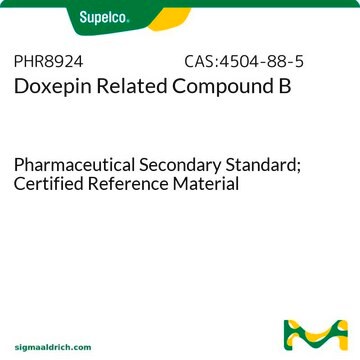Kluczowe dokumenty
Y0000838
Doxepin hydrochloride
European Pharmacopoeia (EP) Reference Standard
Synonim(y):
11-(3-Dimethylaminopropylidene)-6,11-dihydrodibenz[b,e]oxepine hydrochloride
About This Item
Polecane produkty
klasa czystości
pharmaceutical primary standard
rodzina API
doxepin
producent / nazwa handlowa
EDQM
Zastosowanie
pharmaceutical (small molecule)
Format
neat
temp. przechowywania
2-8°C
ciąg SMILES
Cl[H].CN(C)CC\C=C1/c2ccccc2COc3ccccc13
InChI
1S/C19H21NO.ClH/c1-20(2)13-7-11-17-16-9-4-3-8-15(16)14-21-19-12-6-5-10-18(17)19;/h3-6,8-12H,7,13-14H2,1-2H3;1H/b17-11+;
Klucz InChI
MHNSPTUQQIYJOT-SJDTYFKWSA-N
Szukasz podobnych produktów? Odwiedź Przewodnik dotyczący porównywania produktów
Opis ogólny
Zastosowanie
Opakowanie
Inne uwagi
produkt powiązany
Hasło ostrzegawcze
Danger
Zwroty wskazujące rodzaj zagrożenia
Zwroty wskazujące środki ostrożności
Klasyfikacja zagrożeń
Acute Tox. 3 Oral
Kod klasy składowania
6.1C - Combustible acute toxic Cat.3 / toxic compounds or compounds which causing chronic effects
Klasa zagrożenia wodnego (WGK)
WGK 3
Temperatura zapłonu (°F)
Not applicable
Temperatura zapłonu (°C)
Not applicable
Wybierz jedną z najnowszych wersji:
Certyfikaty analizy (CoA)
Przepraszamy, ale COA dla tego produktu nie jest aktualnie dostępny online.
Proszę o kontakt, jeśli potrzebna jest pomoc Obsługa Klienta
Masz już ten produkt?
Dokumenty związane z niedawno zakupionymi produktami zostały zamieszczone w Bibliotece dokumentów.
Nasz zespół naukowców ma doświadczenie we wszystkich obszarach badań, w tym w naukach przyrodniczych, materiałoznawstwie, syntezie chemicznej, chromatografii, analityce i wielu innych dziedzinach.
Skontaktuj się z zespołem ds. pomocy technicznej





